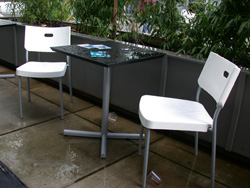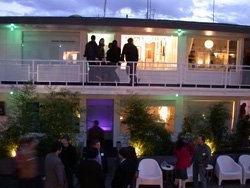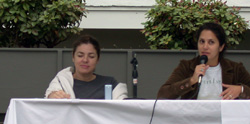
|
||
|
Portland art blog + news + exhibition reviews + galleries + contemporary northwest art
|
||
Some Post-Affair Thoughts
Love it or hate it, the Affair 2005 has come and gone. Yes, the small art in cramped rooms. Yes, the people. Yes, even the rain that threatened to spoil (but only tempered) Friday night's parties. I was out sick last week, no doubt a victim of the elements (standing outside for hours in winter temperatures in the courtyard of the Jupiter will do that), which has given me lots of time to mull over exactly what went on at the Affair. As expected, there was far too much art in hot little cramped rooms - which is part of the joy, because, hell, it's an art fair. It's supposed to feel like a bazaar. It's not supposed to be the ultimate aesthetic experience, but a way to see lots of work from lots of places in a condensed context. Plus, it's rooted in commerce (at least theoretically - read DK Row's comments on that in his "After the Affair" wrap-up). Both last year and this year, I heard complaints about the size of the rooms from several people, but I didn't find that the work suffered any more damage than work at large fairs, for example, in row after row of nondescript booths at NYC's armory fair. And, of course, being in close quarters provides the kind of chance encounters and intimacy that attracted the galleries, particularly those from out of town, in the first place.
Portland being Portland, the Affair is, naturally, a different kind of art fair and its strength lies in its scale. Since Portland is still developing a strong collector's base, and one that still seems to suffer from an attitude of indifference towards collecting work from outside Portland, the sustainablility of its art fair depends on its differences. Talking informally with gallery owners from outside of Portland, who trekked here from cities including San Francisco, Seattle, Atlanta and Houston, it's apparent that this, along with the Portland's well-deserved reputation as a must-see city, was what brought them here, not the promise of lucrative sales. That said, I hope that these types of events will encourage a more sophisticated collector's base, since it's such a crucial element to bringing Portland through its adolescence as an art city. One thing that is sure to continue is the peripheral room projects and events that lend the Affair a more intellectual bent, ensuring that this is a fair with more than just spectacle. Projects by White Columns and Austin's Fluent~Collaborative helped to provide a counterbalance to the commercial presence, but no doubt the best project was a room of photographs and editions by Mona Hatoum , a teaser for a major exhibition of her work at Reed's Cooley Gallery in November, curated by Stephanie Snyder. Continuing a pattern begun last year, there was a Saturday morning panel discussion with a substantial line-up of national guests. On Sunday, Affair-goers willing to trek to the other side of the river to PNCA were treated to a reading by Wayne Koestenbaum of his yet to be published experimental text on the topic of motels. Last year's panel discussion on the cultural tourism of art fairs and biennials (which you can find transcribed in the 2005 Affair program) included Larry Rinder and Saul Ostrow. The discussion was refreshingly international in scope, but I left with the feeling that Portland was still provincial, detached from the kinds of art economies and ecologies active in the cosmopolitan cities under discussion. Perhaps it's just a symptom of a humility that comes from being a native Oregonian combined with a cynicism that surely stems from my liberal arts education (or as some might claim, the fact that I'm married to a European). While the Affair did of course begin as part of a critique of uber-art fairs, it also depends on this system of cultural tourism to lure people here. And, while the complexities of cultural tourism and its implications (both good and bad) were discussed at length, much of the discussion revolved about how fairs and biennials have impacted cities and the international art circuit, a discussion that somehow seemed premature for Portland's very first art fair. This year, the panel tackled the issue of what art patronage means today, which I found to be a very timely topic for Portland in 2005, as the city is trying to figure out how to best help artists on every level, from a concerted city-wide effort to rebrand the city as a cultural hub to grassroots institutions trying to make good on their claims to support local artists. Moderated by Art Papers editor-in-chief Sylvie Fortin, the panel included Austin-based curator Regine Basha, Chicago-based curator and writer Hamza Walker, and two curators who manage large private collections, Andrea Feldman Falcione (Michael and Judy Ovitz) and Kris Kuramitsu (Peter and Eileen Harris Norton). While the panel was less of an interactive discussion and more of a series of monologues on the topic (or in the case of the two private collection curators, promotion for their respective projects), Basha and Walker in particular had valuable insights to offer, some of which crossed-over with Jeff Jahn's current wish list for the city.
Regine Basha is based in Austin, Texas, another city that has experienced a lot of growth within a relatively short period of time. Basha, who is Adjunct Curator at Arthouse, filled in for Lawrence Miller, an idiosyncratic collector in Austin who founded projects including testsite and the non-profit Fluent~Collaborative. Testsite is a 3 year program that was created to bolster the growth of Austin's art community without the heavy-handedness of an institutional model. Testsite's temporary nature is also set up in a way that they can aid the maturation of Austin's art scene without creating a dependency on the institution's presence, certainly not an easy task. Besides the flexibility of its (non)institutional model, I like its program to pair young writers with young artists, a way to not only provide documentation for emerging artists, but a valuable strategy to ensure that a corps of articulate writers with deep knowledge about Austin's art scene will be around in 5 or 10 years. This kind of reasoning is exactly why I'm writing for PORT - artists grow up alongside art administrators, gallerists and writers. Everyone has to reach a new level of sophistication in order for the art scene to fully progress. Another exciting aspect led by Fluent~Collaborative is their effort to help institutions like museums and universities expand their programming by bringing in contemporary artists from outside of Texas (Harrell Flethcer was a guest in 2003). I still shed a tear every time I think about the current state of PICA's visual art program, since they used to be the most dependable source to see contemporary art from outside of Portland (although, I must give lots of credit for the continuation of their excellent lecture series, which is bringing in some key people). And, whenever I hear the line "supporting local artists," the only thing I can think of is that Portland needs a serious mid-level institution far more than yet another DIY grassroots space for emerging local artists. Hamza Walker articulated a very complete explanation of the way that patronage ties into the larger cultural ecology of a city, from its cultural offerings (counting both fringe and mainstream or entertainment culture) to the impact of its institutions (including DIY spaces, museums and schools). Walker had a very interesting point to make about DIY spaces, which he posited are different now from the artist-run DIY spaces of the 1970s. While they were founded to provide an alternative to commercial galleries, a shift in the 1980s led to the rise of the present type of DIY space, which Walker claimed is simply a commercial gallery without money. He asserted that many of today's DIY spaces would be commercial if they had more money pumped into them. An interesting thing to think about, as I can think of at least a couple of grassroots spaces in Portland have pulled chamaeleon-like stunts as they acquire (or try to acquire) more money. I see DIY spaces trying to act as institutions (without the ever-important vision element) as being part of the same dubious path. DIY spaces should have vision and they should exist to provide a true alternative to commercial or institutional entities. Walker also had an important point to make about the hype surrounding the concept of "emerging artists," a frenzy that can be seen everywhere. Walker put it bluntly: "Does emerging artists mean emerging art?" The concept of emerging artist isn't in itself a bad notion, but needs to be considered in terms of the question of how these emerging artists can sustain their practice and mature beyond emerging. As Walker pointed out, the schism between the label of "emerging" and the actual substance of the work needs to be addressed. And, as Sylvie Fortin added, discussions about patronage and emerging art need to bring in the notions of sustainability and mobility. I would add, the same kind of thinking needs to inform discussion of Portland as an emerging arts city - it's not enough to be simply emerging. One must be engaged in a non-static process of emerging into aother level of sophistication, always allowing substance to speak louder than the promises of emergence. Posted by Katherine Bovee on October 13, 2005 at 1:12 | Comments (0) Comments Post a comment Thanks for signing in, . Now you can comment. (sign out)
(If you haven't left a comment here before, you may need to be approved by
the site owner before your comment will appear. Until then, it won't appear
on the entry. Thanks for waiting.)
|
| s p o n s o r s |
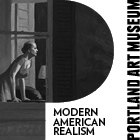 |
 |
 |
 |
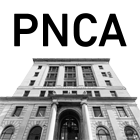 |
 |
 |
 |
 |
 |
 |
 |
 |
 |

|
Site Design: Jennifer Armbrust | • | Site Development: Philippe Blanc & Katherine Bovee | |


